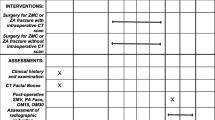Abstract
The objective of this study was to expound a novel surgical management technique assisted by patient-specific implants (PSIs) for comminuted fractures of the zygomaticomaxillary complex (ZMC). The aim of this study was to explore the feasibility of using PSIs to accurately restore and fix comminuted fractures. A male patient with an old ZMC comminuted fracture was used to describe the workflow, technique, and method. Computerassisted surgical simulation was used to determine the optimal plan for the reduction of bone segments prior to surgery. The PSIs were used to accurately guide the surgeon’s position of the bone segments, as planned, during the operation. Oral panoramic films and cephalometric films were taken immediately at 1, 3, 6, and 12 months after the operation, while computed tomography images of the whole skull were taken immediately, half a year, and one year after the operation. The patient’s follow-up showed that the zygomatic symmetry recovered well post-surgery and the patient was satisfied with the outcome. This new surgical method greatly improved the facial symmetry of this patient.
Similar content being viewed by others
References
VAN HOUT W M M T, VAN CANN E M, KOOLE R, et al. Surgical treatment of unilateral zygomaticomaxillary complex fractures: A 7-year observational study assessing treatment outcome in 153 cases [J]. Journal of Cranio-Maxillofacial Surgery, 2016, 44(11): 1859–1865.
JAMAL B T, PFAHLER S M, LANE K A, et al. Ophthalmic injuries in patients with zygomaticomaxillary complex fractures requiring surgical repair [J]. Journal of Oral and Maxillofacial Surgery, 2009, 67(5): 986–989.
KHAQANI M S, TAVOSI F, GHOLAMI M, et al. Analysis of facial symmetry after zygomatic bone fracture management [J]. Journal of Oral and Maxillofacial Surgery, 2018, 76(3): 595–604.
POXLEITNER P, STEYBE D, BUBLITZ B, et al. Analysis of the accuracy of a novel preformed osteosynthesis plate for the reduction and fixation of zygomaticomaxillary complex fractures [J]. Journal of Cranio-Maxillofacial Surgery, 2019, 47(6): 951–958.
EBRAHIMI A, KALANTAR MOTAMEDI M H, RASOULI H R, et al. Enophthalmos and orbital volume changes in zygomaticomaxillary complex fractures: Is there a correlation between them? [J]. Journal of Oral and Maxillofacial Surgery, 2019, 77(1): 134.e1–134.e9.
WANG Y T, CHEN C H, WANG P F, et al. Development of a novel anatomical thin titanium mesh plate with reduction guidance and fixation function for Asian zygomatic-orbitomaxillary complex fracture [J]. Journal of Cranio-Maxillofacial Surgery, 2018, 46(4): 547–557.
BIRGFELD C B, MUNDINGER G S, GRUSS J S. Evidence-based medicine: Evaluation and treatment of zygoma fractures [J]. Plastic and Reconstructive Surgery, 2017, 139(1): 168e–180e.
COOPER T, SCHMUTZ B, HSU E, et al. Magnetic resonance imaging for three-dimensional printing of the bony orbit: Is clinical use imminent? [J]. International Journal of Oral and Maxillofacial Surgery, 2020, 49(4): 483–490.
HO J P T F, SCHREURS R, MILSTEIN D M J, et al. Measuring zygomaticomaxillary complex symmetry three-dimensionally with the use of mirroring and surface based matching techniques [J]. Journal of Cranio-Maxillofacial Surgery, 2016, 44(10): 1706–1712.
YAO B C, HE Y, JIE B M, et al. Reconstruction of bilateral post-traumatic midfacial defects assisted by three-dimensional craniomaxillofacial data in normal Chinese people: A preliminary study [J]. Journal of Oral and Maxillofacial Surgery, 2019, 77(11): 2302.e1–2302.e13.
HE D M, LI Z K, SHI W D, et al. Orbitozygomatic fractures with enophthalmos: Analysis of 64 cases treated late [J]. Journal of Oral and Maxillofacial Surgery, 2012, 70(3): 562–576.
BAO T, YU D, LUO Q, et al. Quantitative assessment of symmetry recovery in navigation-assisted surgical reduction of zygomaticomaxillary complex fractures [J]. Journal of Cranio-Maxillo-Facial Surgery, 2019, 47(2): 311–319.
CUDDY K, KHATIB B, BELL R B, et al. Use of intraoperative computed tomography in craniomaxillofacial trauma surgery [J]. Journal of Oral and Maxillofacial Surgery, 2018, 76(5): 1016–1025.
Author information
Authors and Affiliations
Corresponding author
Rights and permissions
About this article
Cite this article
Zhang, T., Jiang, T., Li, B. et al. Primary Clinical Research of a Patient Specific Implant System for an Old Zygomaticomaxillary Complex Comminuted Fracture. J. Shanghai Jiaotong Univ. (Sci.) 26, 372–376 (2021). https://doi.org/10.1007/s12204-021-2307-3
Received:
Accepted:
Published:
Issue Date:
DOI: https://doi.org/10.1007/s12204-021-2307-3
Key words
- patient-specific implants
- zygomaticomaxillary complex (ZMC)
- comminuted fracture
- 3D printing
- virtual surgery




